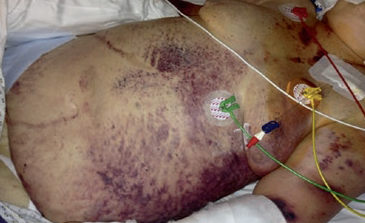Purpura Fulminans
Purpura fulminans is a thrombotic subtype of DIC secondary to protein C deficiency and is characterised by:
The other two subtypes of purpura fulminans are:
- Congenital
Secondary to deficiency of Protein C, Protein S, or Antithrombin III. - Autoimmune
Very rare, secondary to auto-antibody to Protein S.
- Microvascular thrombosis
- Skin necrosis
Epidemiology and Risk Factors
Pathophysiology
Protein C deficiency can result from:
- Consumption
The classical DIC coagulopathy - ↓ Hepatic synthesis
- ↑ Risk with acute liver injury
- Destruction by elastase
Aetiology
| Infective | Non-infective |
|---|---|
Bacterial:
Viral:
Fungal:
Parasitic:
|
Circulatory:
Haematological:
|
Infective causes are significantly more common than non-infective causes.
Clinical Manifestations
Progressive skin changes:

- Initially non-blanching patchy rash
- Mottling
- Generally of extremities
- Skin necrosis
- Within 24-48 hours
- Black necrotic lesions
- May be insensate
- Haemorrhage into skin may cause bullae formation
Diagnostic Approach and DDx
Key differentials:
- Haematological
- Catastrophic antiphospholipid syndrome
- Warfarin-induced skin necrosis
- Vasculitis
- HSP
- Other
- Necrotising fasciitis
- Cocaine toxicity
Investigations
Bedside:
Laboratory:
- FBE
- Thrombocytopaenia
- Coagulation
- INR: 1-3
- PTT: 1-3× ULN
- Fibrinogen: Variable
- D-dimer
Significantly ↑. - Protein C
<40% normal.
Imaging:
Other:
Management
- Treat underlying cause
- Consider anticoagulation
Specific therapy:
- Pharmacological
- Heparin
- anti-Xa targeting due to confounding from APTT measurement
- AT III supplementation may be considered but can result in dramatic ↑ in heparin effect
- Blood product
- Platelets >30
- Fibrinogen >1
- Avoid warfarin
Due to ↓ protein C synthesis.
- Heparin
- Procedural
- Physical
Supportive care:
Disposition:
Preventative:
Marginal and Ineffective Therapies
Anaesthetic Considerations
Complications
- E
- Adrenal insufficiency secondary to adrenal haemorrhage
- F
- AKI
Glomerular thrombosis.
- AKI